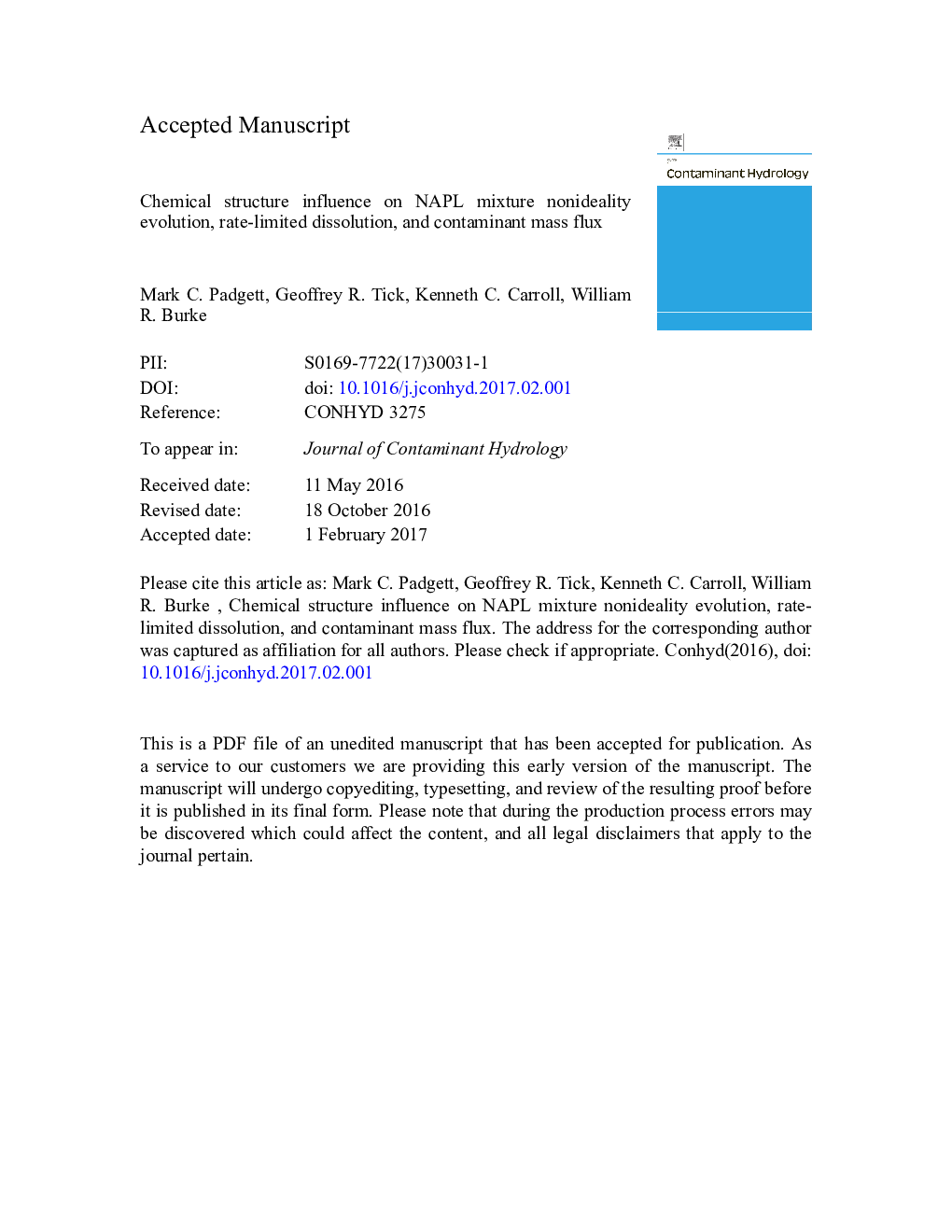| کد مقاله | کد نشریه | سال انتشار | مقاله انگلیسی | نسخه تمام متن |
|---|---|---|---|---|
| 5765934 | 1627013 | 2017 | 57 صفحه PDF | دانلود رایگان |
عنوان انگلیسی مقاله ISI
Chemical structure influence on NAPL mixture nonideality evolution, rate-limited dissolution, and contaminant mass flux
دانلود مقاله + سفارش ترجمه
دانلود مقاله ISI انگلیسی
رایگان برای ایرانیان
کلمات کلیدی
موضوعات مرتبط
مهندسی و علوم پایه
علوم زمین و سیارات
فرآیندهای سطح زمین
پیش نمایش صفحه اول مقاله

چکیده انگلیسی
The influence of chemical structure on NAPL mixture nonideality evolution, rate-limited dissolution, and contaminant mass flux was examined. The variability of measured and UNIFAC modeled NAPL activity coefficients as a function of mole fraction was compared for two NAPL mixtures containing structurally-different contaminants of concern including toluene (TOL) or trichloroethene (TCE) within a hexadecane (HEXDEC) matrix. The results showed that dissolution from the NAPL mixtures transitioned from ideality for mole fractions > 0.05 to nonideality as mole fractions decreased. In particular, the TCE generally exhibited more ideal dissolution behavior except at lower mole fractions, and may indicate greater structural/polarity similarity between the two compounds. Raoult's Law and UNIFAC generally under-predicted the batch experiment results for TOL:HEXDEC mixtures especially for mole fractions â¤Â 0.05. The dissolution rate coefficients were similar for both TOL and TCE over all mole fractions tested. Mass flux reduction (MFR) analysis showed that more efficient removal behavior occurred for TOL and TCE with larger mole fractions compared to the lower initial mole fraction mixtures (i.e. < 0.2). However, compared to TOL, TCE generally exhibited more efficient removal behavior over all mole fractions tested and may have been the result of structural and molecular property differences between the compounds. Activity coefficient variability as a function of mole fraction was quantified through regression analysis and incorporated into dissolution modeling analyses for the dynamic flushing experiments. TOL elution concentrations were modeled (predicted) reasonable well using ideal and equilibrium assumptions, but the TCE elution concentrations could not be predicted using the ideal model. Rather, the dissolution modeling demonstrated that TCE elution was better described by the nonideal model whereby NAPL-phase activity coefficient varied as a function of COC mole fraction. For dynamic column flushing experiments, dissolution rate kinetics can vary significantly with changes in NAPL volume and surface area. However, under conditions whereby NAPL volume and area are not significantly altered during dissolution, mixture nonideality effects may have a greater relative control on dissolution (elution) and MFR behavior compared to kinetic rate limitations.
ناشر
Database: Elsevier - ScienceDirect (ساینس دایرکت)
Journal: Journal of Contaminant Hydrology - Volume 198, March 2017, Pages 11-23
Journal: Journal of Contaminant Hydrology - Volume 198, March 2017, Pages 11-23
نویسندگان
Mark C. Padgett, Geoffrey R. Tick, Kenneth C. Carroll, William R. Burke,